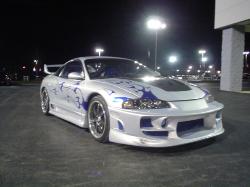Low Marks for Hi Tech
Our main man Daniel Howes of the Detroit News recently asked 'what the Hell happened to mass customization"? Mass customization means building a product to a customer's exact specifications, then delivering it before they get pissed off. As the choice of three trim levels seems to satisfy most sheep– I mean people, I don't thing the Big Three's lack of a Dell-style manufacturing system is a major problem. But the wider point is well taken. When will the auto industry wake up and realize that it's the 21st century?
The continued existence of The North American International Auto Show is the best example of carmakers' inability to accept and accommodate the enormous technological changes that have swept society. Let's face it: it's a dead show walking. Why would anyone other than industry-types on expense accounts fight the crowds, eat horrendous food and PAY to look at a parked car when they can see the same machine driving on their desktop? Besides, by the time Detroit's Cobo Center opens its doors to the frozen throngs, more than 75% of the new cars on display have already debuted in electronic/photographic form.
As well they should. With over 60 new models appearing each year, unveiling dozens of new cars in a single three-day window makes no sense whatsoever. It's like Ben & Jerry's, Hagen Daz, and Baskin & Robbins all announcing their new flavors on the fourth of July weekend. In the multi-media millennium, an actual physical auto show is an expensive, inefficient anachronism. Enthusiasts are sated; civilians are jaded.
The car industry's inability to utilize the web effectively as a sales tool is another example of their lack of contemporary thinking. All the carmakers' websites present a staggering array of product and let the customer have at it. Surfers can research a potential purchase, but the information is devoid of context, warmth or individualization. There's no interactive element recognizing the customer's particular needs and guiding them through the options. No wonder the majority of surfer-buyers peel off to edmunds.com for a better idea of a car's suitability and actual price.
Electronic after-sales contact is just as old fashioned– in the sense that there isn't any. Study after study shows that car buyers want MORE dealer contact, not less. Yet there's no email follow-up to see if drivers know how to operate their car's toys, or to advise them when retrofitted options become available. There's no customer-specific information timed to coincide with usage patterns: winter driving tips, summer vacation planning assistance, trade-in time depreciation updates, etc. There's only… silence.
Computers can keep track of a huge number of buying preferences and behaviors. There's an ever-increasing number of ways to interact with customers: telephone, websites, email, direct mail, text messaging, CD-ROMs and more. But carmakers can't seem to put all these elements together to increase customer satisfaction and loyalty. They act as if the new media is the old media, and put on lingerie competitions at sporting events.
Service departments have also neglected the possibilities inherent in the new technology. With the advent of GPS and on-board telemetries, it's amazing that the dealers' most profitable division still waits for their customers' cars to break down, or for their patrons to remember when it's time for service. Even discounting remote interrogation, surely there's an algorithm that can predict what will go wrong with a customer's car before it occurs, taking into account the customer's probable (or actual) driving habits and nationwide, model-specific service patterns.
And finally, the cars themselves show an inexplicable reluctance to evolve towards modern sensibilities. Computer interfaces like BMW's iDrive and Audi's MMI controllers seem to reflect a cutting edge hi-tech ethos. In fact, these awkward devices betray a stunning ignorance of simple ergonomics, requiring unacceptable physical, visual and mental diversion from the mission critical task of driving. What happened to the kind of thinking that led to the gentle red light glowing over a BMW's dash or GM's heads-up display? We don't need more technology, we need BETTER technology.
The obvious way to conclude this rant is to talk about supertanker turning circles, dinosaur brains and the possibility of smaller, faster car companies taking over from the large, unwieldy ones. But I won't go there. Instead, I refer you to America's gigantic after-market tuning industry. These guys build to suit, party with their customers and innovate on a daily basis. If Danny wants to know where to find mass customization, he could do worse than to watch Pimp My Ride.
More by Robert Farago
Latest Car Reviews
Read moreLatest Product Reviews
Read moreRecent Comments
- Corey Lewis It's not competitive against others in the class, as my review discussed. https://www.thetruthaboutcars.com/cars/chevrolet/rental-review-the-2023-chevrolet-malibu-last-domestic-midsize-standing-44502760
- Turbo Is Black Magic My wife had one of these back in 06, did a ton of work to it… supercharger, full exhaust, full suspension.. it was a blast to drive even though it was still hilariously slow. Great for drive in nights, open the hatch fold the seats flat and just relax.Also this thing is a great example of how far we have come in crash safety even since just 2005… go look at these old crash tests now and I cringe at what a modern electric tank would do to this thing.
- MaintenanceCosts Whenever the topic of the xB comes up…Me: "The style is fun. The combination of the box shape and the aggressive detailing is very JDM."Wife: "Those are ghetto."Me: "They're smaller than a Corolla outside and have the space of a RAV4 inside."Wife: "Those are ghetto."Me: "They're kind of fun to drive with a stick."Wife: "Those are ghetto."It's one of a few cars (including its fellow box, the Ford Flex) on which we will just never see eye to eye.
- Oberkanone The alternative is a more expensive SUV. Yes, it will be missed.
- Ajla I did like this one.





































Comments
Join the conversation